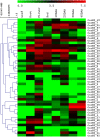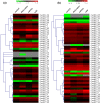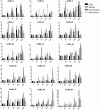A comprehensive analysis of the B3 superfamily identifies tissue-specific and stress-responsive genes in chickpea (Cicer arietinum L.)
- PMID: 31497464
- PMCID: PMC6710316
- DOI: 10.1007/s13205-019-1875-5
A comprehensive analysis of the B3 superfamily identifies tissue-specific and stress-responsive genes in chickpea (Cicer arietinum L.)
Abstract
The aim of this study was to provide a comprehensive analysis of the plant-specific B3 domain-containing transcription factors (TFs) in chickpea. Scanning of the chickpea genome resulted in the identification of 51 B3 domain-containing TFs that were located on seven out of eight chickpea chromosomes. Based on the presence of additional domains other than the B3 domain, the candidates were classified into four subfamilies, i.e., ARF (24), REM (19), LAV (6) and RAV (2). Phylogenetic analysis classified them into four groups in which members of the same group had similar intron-exon organization and motif composition. Genome duplication analysis of the candidate B3 genes revealed an event of segmental duplication that was instrumental in the expansion of the B3 gene family. Ka/Ks analysis showed that the B3 gene family was under purifying selection. Further, chickpea B3 genes showed maximum orthology with Medicago followed by soybean and Arabidopsis. Promoter analyses of the B3 genes led to the identification of several tissue-specific and stress-responsive cis-regulatory elements. Expression profiling of the candidate B3 genes using publicly available RNA-seq data of several chickpea tissues indicated their putative role in plant development and abiotic stress response. These findings were further validated by real-time expression analysis. Overall, this study provides a comprehensive analysis of the B3 domain-containing proteins in chickpea that would aid in devising strategies for crop manipulation in chickpea.
Keywords: B3 domain-containing protein; Chickpea; Expression analysis; Phylogeny.
Conflict of interest statement
Conflict of interestOn behalf of all authors, the corresponding author states that there is no conflict of interest.
Figures







Similar articles
-
Genome-wide identification of the auxin response factor gene family in Cicer arietinum.BMC Genomics. 2018 Apr 27;19(1):301. doi: 10.1186/s12864-018-4695-9. BMC Genomics. 2018. PMID: 29703137 Free PMC article.
-
Genome-Wide Analysis of the Aquaporin Gene Family in Chickpea (Cicer arietinum L.).Front Plant Sci. 2016 Nov 29;7:1802. doi: 10.3389/fpls.2016.01802. eCollection 2016. Front Plant Sci. 2016. PMID: 27965700 Free PMC article.
-
Genome-wide identification and expression analyses of WRKY transcription factor family members from chickpea (Cicer arietinum L.) reveal their role in abiotic stress-responses.Genes Genomics. 2019 Apr;41(4):467-481. doi: 10.1007/s13258-018-00780-9. Epub 2019 Jan 12. Genes Genomics. 2019. PMID: 30637579
-
Genome-wide analysis of the CCCH zinc finger family identifies tissue specific and stress responsive candidates in chickpea (Cicer arietinum L.).PLoS One. 2017 Jul 12;12(7):e0180469. doi: 10.1371/journal.pone.0180469. eCollection 2017. PLoS One. 2017. PMID: 28704400 Free PMC article.
-
The plant B3 superfamily.Trends Plant Sci. 2008 Dec;13(12):647-55. doi: 10.1016/j.tplants.2008.09.006. Epub 2008 Nov 3. Trends Plant Sci. 2008. PMID: 18986826 Review.
Cited by
-
Genome-Wide Analysis of the Molecular Functions of B3 Superfamily in Oil Biosynthesis in Olive (Olea europaea L.).Biomed Res Int. 2023 Feb 14;2023:6051511. doi: 10.1155/2023/6051511. eCollection 2023. Biomed Res Int. 2023. PMID: 36825035 Free PMC article.
-
Identification of loci controlling timing of stem elongation in red clover using genotyping by sequencing of pooled phenotypic extremes.Mol Genet Genomics. 2022 Nov;297(6):1587-1600. doi: 10.1007/s00438-022-01942-x. Epub 2022 Aug 24. Mol Genet Genomics. 2022. PMID: 36001174 Free PMC article.
-
Genome Wide Identification and Annotation of NGATHA Transcription Factor Family in Crop Plants.Int J Mol Sci. 2022 Jun 25;23(13):7063. doi: 10.3390/ijms23137063. Int J Mol Sci. 2022. PMID: 35806066 Free PMC article.
-
Comprehensive analysis of B3 family genes in pearl millet (Pennisetum glaucum) and the negative regulator role of PgRAV-04 in drought tolerance.Front Plant Sci. 2024 Jul 29;15:1400301. doi: 10.3389/fpls.2024.1400301. eCollection 2024. Front Plant Sci. 2024. PMID: 39135652 Free PMC article.
-
Genome-wide characterization and expression profiling of B3 superfamily during ethylene-induced flowering in pineapple (Ananas comosus L.).BMC Genomics. 2021 Jul 21;22(1):561. doi: 10.1186/s12864-021-07854-1. BMC Genomics. 2021. PMID: 34289810 Free PMC article.
References
LinkOut - more resources
Full Text Sources

